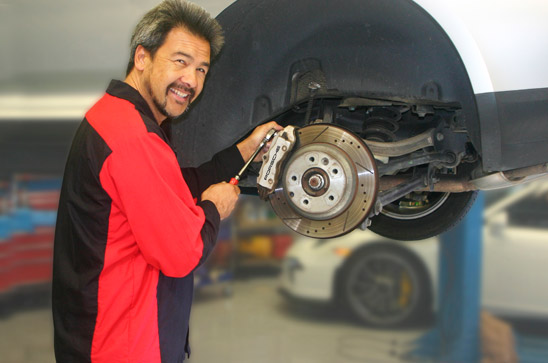
David performing a quality brake repair.
Typical Porsche Brake Repairs
The Master Cylinder
When a driver puts on the brakes, that force moves a push rod in the master cylinder, creating hydraulic pressure. A pair of pistons (primary and secondary) is mounted on the push rod; the pistons work in tandem to push against the fluid in the master cylinder bore. Since the fluid is not compressible, this action creates pressure which displaces the fluid from the master cylinder. This expulsion exerts pressure through the brake lines, causing the brakes to slow the vehicle.
The master cylinder converts the force exerted on the brake pedal by the vehicle’s driver into hydraulic pressure to apply the brakes. Depressing the brake pedal moves a push rod in the master cylinder. Mounted on the push rod are a pair of pistons (primary and secondary) in tandem (one after the other) to push against the fluid in the master cylinder bore. This creates pressure that displaces fluid since it’s incompressible. As fluid is pushed from the master cylinder, it exerts pressure through the brake lines to apply each of the brakes.
Releasing the brake pedal causes the spring-loaded piston assembly in the master cylinder to return to its resting position. When the brake pedal is released, the spring-loaded piston assembly in the master cylinder returns to its rest position. The fluid that was displaced by the pistons is pushed back to the master cylinder as the disc brake pads kick out away from the rotors, and the springs inside the drums retract the brake shoes. The fluid returns to the fluid reservoir through the “compensating ports,” which are small openings between the master cylinder bore and fluid reservoir just ahead in front of each of the pistons.
Master cylinders are divided into two separate hydraulic circuits, with each having its own fluid reservoir and piston. This is a safety requirement so that if a leak occurs in one circuit, it won’t affect the other circuit, leaving at least two brakes operational to stop the vehicle. With most rear-wheel-drive (RWD) vehicles, cars, the hydraulic system is divided front-to-rear, with one circuit for the front brakes and a second circuit for the rear brakes. On many front-wheel-drive (FWD) cars, the brake system is split diagonally. The left front and right rear brakes share comprise one circuit, while the right front and left rear brakes share the other.
The most common problems that occur in the master cylinder is wear in the piston bore and piston seal failure. The classic symptom of a failing master cylinder is a “squishy” brake pedal that slowly sinks while when pressure is held against applied to the pedal. The cure is to replace the master cylinder.
Generally, the brake master cylinder fails for two reasons: 1) a leak may develop internally and the seal goes bad, thus creating a lack of pressure when you press the brake pedal is depressed; 2) externally, a leak may develop occur at the main part of the seal where the push rod comes into the cylinder.
When replacing the master cylinder it’s possible that it may be that the brake booster also needs replacing. If a failing braking brake master cylinder leaks into the booster, it may cause the diaphragm to wear out prematurely or rupture. Brake fluid is quite corrosive, so as at this time we’ll also inspect the vacuum lines too the brake





